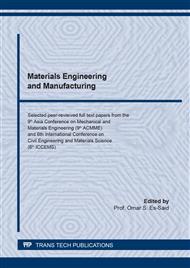p.3
p.9
p.15
p.20
p.25
p.31
p.41
p.50
The Mechanical and Thermal Properties of MWCNT/ZnO/Polyethylene Composites
Abstract:
In this paper, multiwall carbon nanotube-ZnO (MWCNT/ZnO) was melt-blended with polyethylene (PE) by a Haake-Buchler Rheomixer. The mechanical properties, thermal stability and dispersion degree of the composite materials was characterized. Differential scanning calorimetry, X-ray diffraction analysis, thermogravimetry, tensile test and SEM were carried out. The results showed that with the addition of MWCNT/ZnO, the crystallinity and thermal degradation temperature of PE changed. 0.2phr MWCNT/ZnO/PE exhibited crystallinity that was 10% higher than PE. With the addition of MWCNT/ZnO, the tensile strength of PE decreased gradually, but the elongation at break increased first and then decreased. When MWCNT/ZnO content is 0.2phr, the elongation at break of the composite is close to 532.21%, which is 116% higher than that of pure PE.
Info:
Periodical:
Pages:
9-14
Citation:
Online since:
October 2021
Authors:
Price:
Сopyright:
© 2021 Trans Tech Publications Ltd. All Rights Reserved
Share:
Citation:


